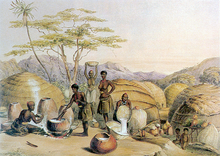Nguni homestead
A homestead (Xhosa: umzi) in southern Africa is a cluster of several houses, typically occupied by a single extended family and often with an attached kraal.
[1] Homesteads may make use of commercially available materials, but nonetheless inherit traditional construction methods to retain an often semi-circular arrangement of vernacular architecture.
He offers, for example, the prominence of spacial division (left-right) as being reflected in the Zulu regiment’s classification, with those quartered rightmost always of higher status than the left.
Debates over the historicity of a general structure of the homestead and its use determining ethnographic and archeological significance makes characterizations on form and function difficult.
This effect is in part due to studies by anthropologists who have contributed prominent ethnographic data on Zulu settlements, such as Eileen Krige, William David Hammond-Tooke, Nicolaas van Warmelo, and James Stewart.
